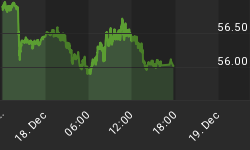Last Friday a photograph of a dress, whose exact colors were in doubt and became the subject of much debate, dominated the Internet. Not only is this a perfect example of the inane distractions that the public is fascinated with, but it is also a topic that should be elevated to a higher level of discussion. That is, how people can look at the same thing and yet interpret it in different ways?
Are Happy Days Really Here Again?
The current picture of economic growth in the United States is undergoing a similar debate. During the second and third quarters of 2014, Wall Street popped champagne corks because the average of the two periods displayed 4.8 percent economic growth. The better-than-expected GDP, coupled with a steady decline in the unemployment rate, led many to believe that our seven years of economic malaise were over. The economy appeared colored in growth -- happy days were here again!
Unfortunately, the celebrations proved premature. Fourth quarter GDP has been revised downward to an annualized rate of 2.2 percent, not the 2.6 percent analysts had been expecting. And full-year GDP growth came in at an underwhelming 2.4 percent. Turning to data in Q1 this year, the Chicago PMI came in at 45.8, indicating contraction in the manufacturing sector in the Midwest for the first time since April 2013, and the number of Americans seeking first-time unemployment benefits rose last week back above the 300,000 mark.
But the bad news doesn't end there. In January existing Home Sales fell sharply to their lowest level in nine months, and despite bullish calls for consumer spending to be bolstered by falling energy prices, consumer outlays fell in both December and January, the first two-month decline since 2009.
Greenspan's Parallels Today's U.S. To Year 1937 Of The Great Depression
The former Chairman of the Federal Reserve, Alan Greenspan, doesn't think the color of the economy is all rosy. He told CNBC's "closing Bell" that effective demand is extraordinarily weak. Referring to the depression inside the Great Depression that occurred in 1937, he said, "The way I measure it, it's probably tantamount to what we saw in the later stages of the Great Depression."
Among other things, Greenspan blames entitlements for crowding out savings, a critical aspect to investing, and crowding out capital investment. Greenspan continued, "Capital investment is key to productivity growth. That has slowed down quite dramatically and productivity has followed right along."
Former Treasury Secretary Larry Summers sees the economy in shades similar to Greenspan. And he has a name for this color: "secular stagnation." Summers contends that the inflation-adjusted Fed Funds Rate should be as low as negative 2-3 percent "forever."
More Fed Propaganda
Despite the bleak hue seen by some, many of those who work at the Fed see the economy colored in blue skies forever and are confident we will see 3 percent growth this year. In fact, some members of the Federal Open Market Committee see the economic picture as so bright that they believe the Fed should dull it with immediate rate hikes.
St. Louis Fed President James Bullard, who is generally hawkish, called for rate hikes as part of "the normalization process," as he expects the unemployment rate to fall below 5 percent in the second half of this year and overall economic growth to be 3 percent for 2015.
Bullard claims, "These labor markets are improving so rapidly ... if you haven't even come off zero and the unemployment rate has come down below 5 percent, that seems a little bit extreme to me."
Likewise, Federal Reserve Vice Chairman Stanley Fischer said recently, "If the labor market continues to strengthen, and if we see inflation beginning to increase, then the natural thing is to get the interest rates up."
But perhaps Bullard and Fischer should review their color charts. The last time we had annual GDP growth over 3 percent was in 2005. We have spent the last nine years growing well below the 3 percent level, despite the Fed's unprecedented accommodation. In case they forgot, we had the following growth rates for the past five years: 2010, 2.5 percent; 2011, 1.6 percent; 2012, 2.3 percent; 2013, 2.2 percent; 2014, 2.4 percent.
Why would the economy suddenly start growing at 3 percent if "quantitative easing" has ended and interest rates are projected to start rising? Do they expect companies to start building factories because the cost of capital is increasing, when they didn't build those factories when the cost of capital was next to nothing? Or do these color-blind pundits think that collapsing asset prices will finally spur consumer demand that has been absent for nearly a decade?
The Harsh Reality
While those at the Fed are busy tinkering with their color wheel, they are missing the contractionary and deflationary data points hanging all around them. They have spent the last seven years "mixing paint," but the economy has shown no signs of sustainable and robust growth.
The only things we have to show for years of central banks' absolute domination of free markets are worldwide asset bubbles in real estate, equities, and sovereign debt.
And now true to form, the Fed's reading of the economy is 180 degrees away from the economy's actual condition. Since our central planners have managed to artificially bring the belly of the yield curve down to around 2 percent, it won't take many increases in the Fed funds rate before banks find it unprofitable to make loans -- and the economy shuts down just as it did in 2000 and 2007.
So once the Fed raises interest rates just a few times and flattens the yield curve, the real color of this economy's "dress" will become clear to everyone -- and it is sackcloth and ashes.
Michael Pento produces the weekly podcast "The Mid-week Reality Check", is the President and Founder of Pento Portfolio Strategies and Author of the book "The Coming Bond Market Collapse."















